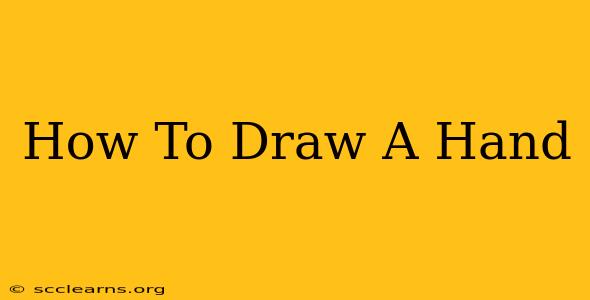Drawing hands can be intimidating, even for experienced artists. They're complex, with many small bones and muscles that affect their shape and movement. But don't worry! With a little practice and the right approach, you can learn how to draw a hand beautifully and realistically. This guide breaks down the process into manageable steps, perfect for beginners.
Understanding Hand Anatomy: The Foundation of Realistic Drawing
Before we start sketching, let's briefly examine the basic anatomy of a hand. This understanding will significantly improve your ability to create believable hand drawings.
Key Elements:
- Palm: The fleshy base of the hand.
- Fingers: Four fingers (index, middle, ring, and little finger) and a thumb. Note the varying lengths of the fingers.
- Knuckles: The joints where your fingers bend. Notice the alignment and how they create distinct bumps.
- Wrist: The connection point between your hand and forearm.
Step-by-Step Guide to Drawing a Hand
Now, let's get to the drawing! We'll work through a simple method that builds up the hand gradually.
Step 1: Sketching the Basic Shapes
Start with simple geometric shapes to map out the overall structure of the hand. Think of the palm as a rectangle or slightly trapezoidal shape, and the fingers as elongated rectangles or cylinders. This helps to establish proportions and positions before adding detail. Don't worry about perfection at this stage; it's just a guideline.
Step 2: Refining the Shapes
Now, gently refine those initial shapes, making the palm more rounded and the fingers more tapered. Pay close attention to the curvature of the palm and the subtle curves of each finger. Begin to indicate the knuckles with small circles or ovals. Remember, hands aren't perfectly straight; they have gentle bends and curves even when relaxed.
Step 3: Adding Detail and Defining Features
Start adding more detail. Sketch in the fingernails, paying attention to their shape and curvature. Refine the knuckles, adding subtle shadows and highlights to give them depth. Lightly sketch in the creases and lines of the palm and fingers, these are important in conveying realism. Observe real hands for reference!
Step 4: Shading and Highlights
This is where your drawing truly comes to life. Use shading to create depth and dimension. Observe where the light source is coming from and add shadows accordingly. Pay particular attention to the areas between the fingers and knuckles, where shadows often accumulate. Add highlights to the raised areas of the hand to bring them forward.
Step 5: Final Refinements and Details
Take a step back and assess your drawing. Are the proportions correct? Do the shadows and highlights make sense? Are the details accurate? Make any necessary adjustments to refine your drawing. This step might involve erasing and redrawing certain parts to achieve the desired level of realism.
Tips and Tricks for Drawing Hands
- Use References: Don't rely solely on your memory. Use photos or even your own hand as a reference. Observing real hands closely will greatly improve your understanding of their form and structure.
- Practice Regularly: The key to improving your hand-drawing skills is consistent practice. Try sketching hands in various positions and perspectives.
- Break it Down: Don't try to draw the entire hand at once. Focus on individual sections – the palm, fingers, thumb – and work on each part separately before combining them.
- Experiment with Different Styles: Don't limit yourself to realism. Experiment with different drawing styles, like cartoonish or stylized hands. This can help you develop your creative skills and find your own unique artistic voice.
- Be Patient: Drawing hands takes time and patience. Don’t get discouraged if your first attempts aren’t perfect. Keep practicing, and you’ll see significant improvement over time.
By following these steps and practicing consistently, you'll be well on your way to mastering the art of drawing hands. Remember, practice makes perfect! So grab a pencil, some paper, and start creating!

